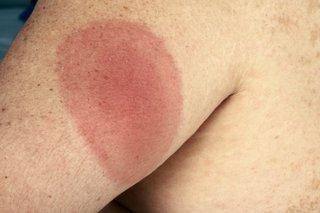Lyme disease
Lyme disease is a bacterial infection that can be spread to humans by infected ticks. It's usually easier to treat if it's diagnosed early.
Symptoms of Lyme disease
Many people with early symptoms of Lyme disease develop a circular red skin rash around a tick bite.
The rash can appear up to 3 months after being bitten by a tick and usually lasts for several weeks.
Most rashes appear within the first 4 weeks.


Not everyone with Lyme disease gets the rash. Some people also have flu-like symptoms in the early stages, such as:
- a high temperature, or feeling hot and shivery
- headaches
- muscle and joint pain
- tiredness and loss of energy
Other symptoms of Lyme disease
Most tick bites are harmless
Only a small number of ticks are infected with the bacteria that cause Lyme disease.
A tick bite can only cause Lyme disease in humans if the tick has already bitten an infected animal.
But it's still important to be aware of ticks and to safely remove them as soon as possible, just in case.
Ticks that may cause Lyme disease are found all over the UK, but high-risk areas include grassy and wooded areas in southern England and the Scottish Highlands.
What are ticks?
How to spot and remove ticks
Important
Tick bites are not always painful. You may not notice a tick unless you see it on your skin.
Regularly check your skin and your children's or pets' skin after being outdoors.
To remove a tick safely:
- Use fine-tipped tweezers or a tick-removal tool. You can buy these from some pharmacies, vets and pet shops.
- Grasp the tick as close to the skin as possible.
- Slowly pull upwards, taking care not to squeeze or crush the tick. Dispose of it when you have removed it.
- Clean the bite with antiseptic or soap and water.
The risk of getting ill is low. You do not need to do anything else unless you become unwell.

See a GP if:
- you have been bitten by a tick or visited an area in the past month where infected ticks are found
and you get:
- flu-like symptoms – such as feeling hot and shivery, headaches, aching muscles or feeling sick, or
- a circular red rash
Tell them if you have been in forests or grassy areas.
What happens at your appointment
Your GP will ask about your symptoms and consider any rash or recent tick bites you know about.
Lyme disease can be difficult to diagnose. It has similar symptoms to other conditions and there's not always an obvious rash.
Two types of blood test are available to help confirm or rule out Lyme disease. But these tests are not always accurate in the early stages of the disease.
You may need to be retested if you still have Lyme disease symptoms after a negative result.
Treatment from a GP
If your GP thinks you might have Lyme disease, they'll prescribe a 3-week course of antibiotics. It's important to finish the course, even if you start to feel better.
Some people with severe symptoms will be referred to a specialist in hospital for injections of antibiotics.
Most people with Lyme disease get better after antibiotic treatment. This can take months for some people, but the symptoms should improve over time.
People with symptoms of Lyme disease that last a long time after treatment may be referred to a specialist in hospital for advice and more blood tests.
Important
Some websites offer tests and treatment for Lyme disease that may not be supported by scientific evidence.
Speak to your doctor for advice before buying tests or treatment online.
How to avoid tick bites
To reduce the risk of being bitten:
- cover your skin while walking outdoors and tuck your trousers into your socks
- use insect repellent on your clothes and skin – products containing DEET are best
- stick to paths whenever possible
- wear light-coloured clothing so ticks are easier to spot and brush off
Ongoing symptoms
A few people who are diagnosed and treated for Lyme disease continue to have symptoms, like tiredness, aches and loss of energy, that can last for years.
These symptoms are often compared to fibromyalgia and chronic fatigue syndrome.
It's not clear why this happens to some people and not others. This means there's also no agreed treatment.
Speak to your doctor if your symptoms come back after treatment with antibiotics or they do not start to improve.
Your doctor may be able to offer you further support if needed, such as:
- referral for a care needs assessment
- telling your employer, school or higher education institution that you require a gradual return to activities
- communicating with children and families' social care